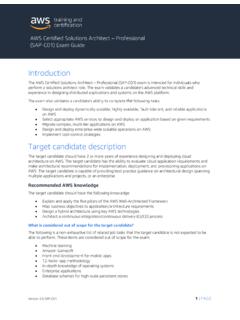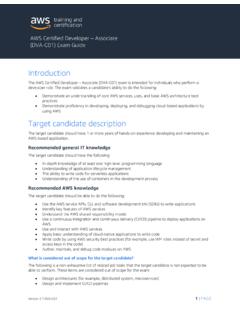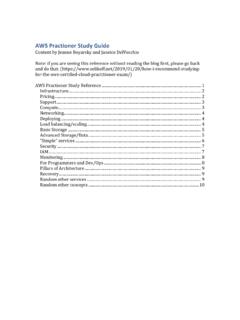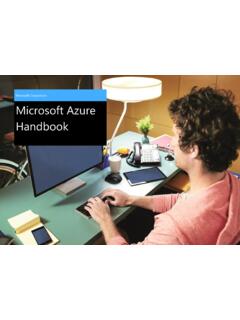Transcription of Cover page - Tutorialspoint
1 Cover page Android About the Tutorial Android is an open-source, Linux-based operating system for mobile devices such as smartphones and tablet computers. Android was developed by the Open Handset Alliance, led by Google, and other companies. This tutorial will teach you the basic Android programming and will also take you through some advance concepts related to Android application development. Audience This tutorial has been prepared for beginners to help them understand basic Android programming. After completing this tutorial, you will find yourself at a moderate level of expertise in Android programming from where you can take yourself to next levels.
2 Prerequisites Android programming is based on Java programming language. If you have a basic understanding of Java programming, then it will be fun to learn Android application development. Copyright & Disclaimer Copyright 2014 by Tutorials Point (I) Pvt. Ltd. All the content and graphics published in this e-book are the property of Tutorials Point (I). Pvt. Ltd. The user of this e-book is prohibited to reuse, retain, copy, distribute or republish any contents or a part of contents of this e-book in any manner without written consent of the publisher. We strive to update the contents of our website and tutorials as timely and as precisely as possible, however, the contents may contain inaccuracies or errors.
3 Tutorials Point (I) Pvt. Ltd. provides no guarantee regarding the accuracy, timeliness or completeness of our website or its contents including this tutorial. If you discover any errors on our website or in this tutorial, please notify us at i Android Table of Contents About the Tutorial .. i i i Copyright & Disclaimer .. i 1. ANDROID 1. What is Android? .. 1. Features of Android .. 1. Android Applications .. 2. 2. ANDROID ENVIRONMENT 3. Step 1 - Setup Java Development Kit (JDK).. 3. Step 2 - Setup Android SDK .. 4. Step 3 - Setup Eclipse IDE .. 5. Step 4 - Setup Android Development Tools (ADT) Plugin.
4 6. Step 5 - Create Android Virtual Device .. 8. 3. ANDROID ARCHITECTURE .. 10. Linux kernel .. 10. Libraries .. 10. Android Runtime .. 11. Application Framework .. 11. Applications .. 11. 4. ANDROID APPLICATIONS COMPONENT .. 12. Activities .. 12. services .. 12. Broadcast Receivers .. 13. ii Android Content Providers .. 13. Additional Components .. 13. 5. ANDROID HELLO WORLD EXAMPLE .. 15. Create Android Application .. 15. Anatomy of Android Application .. 16. The Main Activity File .. 18. The Manifest File .. 19. The Strings File .. 20. The R File .. 21. The Layout File .. 22. Running the Application.
5 23. 6. ANDROID ORGANIZING & ACCESSING THE RESOURCES .. 24. Organize Resources .. 24. Alternative Resources .. 25. Accessing Resources .. 27. Accessing Resources in Code .. 27. Accessing Resources in XML .. 28. 7. ANDROID ACTIVITIES .. 30. 8. ANDROID services .. 36. 9. ANDROID BROADCAST 46. Creating the Broadcast Receiver .. 46. Registering Broadcast Receiver .. 46. Broadcasting Custom Intents .. 48. 10. ANDROID CONTENT 55. Content 55. iii Android Create Content Provider .. 56. 11. ANDROID FRAGMENTS .. 70. Fragment Life Cycle .. 71. How to use Fragments? .. 72. 12. ANDROID INTENTS & FILTERS.
6 80. Intent Objects .. 80. Action .. 81. Data .. 81. Category .. 82. Extras .. 82. Flags .. 82. Component 82. Types of Intents .. 82. Explicit Intents .. 82. Implicit Intents .. 83. Intent Filters .. 88. 13. ANDROID UI LAYOUTS .. 98. Android Layout Types .. 99. Layout Attributes .. 99. View Identification .. 102. 14. ANDROID UI CONTROLS .. 103. Android UI Controls .. 103. Create UI Controls .. 105. 15. ANDROID EVENT HANDLING .. 106. Event Listeners & Event Handlers .. 106. iv Android Event Listeners Registration: .. 107. Event Handling Examples .. 107. Registration Using the Activity Implements Listener Interface.
7 112. Registration Using Layout file .. 115. Exercise: .. 118. 17. ANDROID STYLES & THEMES .. 119. Defining Styles .. 119. Using Styles .. 120. Style Inheritance .. 120. Android Themes .. 122. Default Styles & Themes .. 122. 18. ANDROID CUSTOM 123. Creating a Simple Custom Component .. 123. Instantiate using code inside activity class .. 124. Instantiate using Layout XML file .. 124. Custom Component with Custom Attributes .. 125. Step 1 .. 126. Step 2 .. 126. Step 3 .. 127. 19. ANDROID DRAG & DROP .. 129. The Drag/Drop Process .. 129. The DragEvent Class .. 130. Listening for Drag Event.
8 131. Starting a Drag Event .. 131. 20. ANDROID NOTIFICATIONS .. 138. Create and Send Notifications .. 139. v Android The 140. Big View Notification .. 151. 21. ANDROID LOCATION-BASED services .. 154. The Location Object .. 154. Get the Current Location .. 156. Get the Updated Location .. 157. Location Quality of Service .. 157. Displaying a Location 158. Install the Google Play services SDK .. 158. Create Android Application .. 159. 22. ANDROID SENDING EMAIL .. 170. Intent Object - Action to send Email .. 170. Intent Object - Data/Type to send Email .. 170. Intent Object - Extra to send Email.
9 170. 23. ANDROID SENDING 178. Using SmsManager to send SMS .. 178. Using Built-in Intent to send SMS .. 185. Intent Object - Action to send SMS .. 185. Intent Object - Data/Type to send 185. Intent Object - Extra to send SMS .. 185. 24. ANDROID PHONE CALLS .. 192. Intent Object - Action to make Phone Call .. 192. Intent Object - Data/Type to make Phone Call .. 192. 25. ANDROID PUBLISHING ANDROID 199. Export Android 200. vi Android Google Play Registration .. 204. 26. ANDROID ALERT DIALOG TUTORIAL .. 206. 27. ANDROID ANIMATIONS .. 220. Tween Animation .. 220. Zoom in 221. 28. ANDROID AUDIO 235.
10 29. ANDROID AUDIO 248. 30. ANDROID AUTOCOMPLETE .. 261. 31. ANDROID BEST PRACTICES .. 271. Best Practices - User input .. 271. Best Practices - Performance .. 272. Best Practices - Security and privacy .. 272. 32. ANDROID BLUETOOTH .. 283. 33. ANDROID CAMERA .. 297. Using existing android camera application in our application .. 297. Directly using Camera API Provided by Android in our Application .. 306. 34. ANDROID CLIPBOARD .. 317. Copying data .. 317. Pasting data .. 318. 35. ANDROID CUSTOM FONTS .. 328. 36. ANDROID DATA BACKUP .. 333. Test your BackupAgent .. 337. 37. ANDROID DEVELOPER TOOLS.













